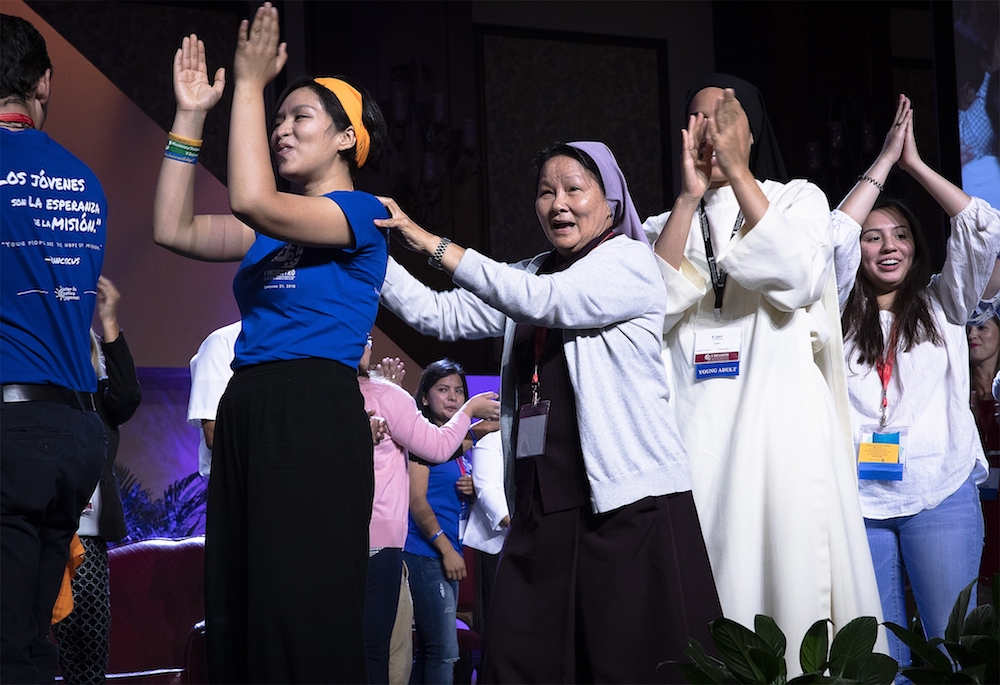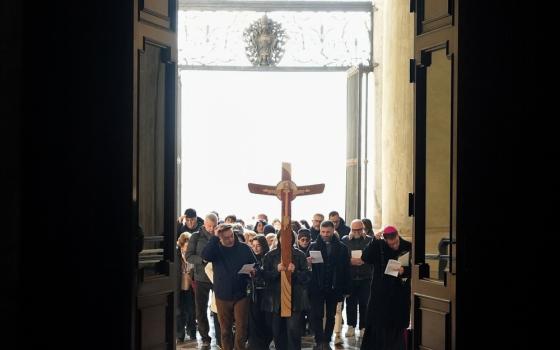
Delegates celebrate at the closing session of a gathering of Hispanic Catholics in Texas in September. Among Americans ages 18-29, 9% are Hispanic Catholics, while 8% are white Catholics. (CNS photo/Tyler Orsburn)
A new report from the Public Religion Research Institute examined the U.S. religious landscape, and declared that "the most substantial cultural and political divides are between white Christians and Christians of color."
"More than four in 10 Americans (44%) identify as white Christian, including white evangelical Protestants (14%), white mainline Protestants (16%) and white Catholics (12%), as well as small percentages who identify as Latter-day Saint (Mormon), Jehovah's Witness and Orthodox Christian," said the report, "The 2020 Census of American Religion," released July 8.
"Over the last few decades, the proportion of the U.S. population that is white Christian has declined by nearly one-third. As recently as 1996, almost two-thirds of Americans (65%) identified as white and Christian. By 2006, that had declined to 54%, and by 2017 it was down to 43%," the report said.
"The proportion of white Christians hit a low point in 2018, at 42%, and rebounded slightly in 2019 and 2020, to 44%. That tick upward indicates the decline is slowing from its pace of losing roughly 11% per decade."
As for Catholics, according to the report, the number of white Catholics has "also declined from a high point of 16% of the population in 2008, and their low point of 11% occurred in 2018. It is unclear if the bump back up to 12% in 2020 indicates a new trend."
It added, "The slight increase in white Christians between 2018 and 2020 was driven primarily by an uptick in the proportion of white mainline Protestants and a stabilization in the proportion of white Catholics."
Hispanic Catholics total 8% of Americans, PRRI said, and "other Catholics of color" come in at 2%.
But Hispanic Catholics are coming into a numerical ascendancy, the report said. Among Americans ages 18-29, 9% are Hispanic Catholics, while 8% are white Catholics.

Parishioners pray after receiving communion at St. Louis Catholic Church in Batesvill, Indiana. The proportion of Americans who identify as white Catholics has dropped from six in 10 in 1996 to four in 10 today, according to a new survey. (CNS photo/Katie Rutter)
"The proportion of white Catholics dropped from 18% in 2013 to 15% in 2020," the report said. "By contrast, the proportion of religiously unaffiliated seniors increased from 11% in 2013 to 14% in 2020."
The PRRI report looked at other demographic trends in American religious identity.
The median age of all Americans is 47, but for white Catholics it's 54 — topped only by white evangelical Protestants at 56. The median age of Hispanic Catholics rose from 39 in 2013 to 42 in 2020.
Forty-two percent of white Catholics held college degrees, but only 15% of Hispanic Catholics did — the lowest percentage identified among any religious group in the survey.
Of white Americans, 19% are Catholic, and of Black Americans, 7% are Catholic, while 11% of multiracial Americans identify as Catholic, PRRI said. Fully half of Hispanic Americans are Catholic and 76% of Hispanics identify as Christian.
Among Asian-Americans, 34% are Christian, with Catholics, evangelical Protestants and mainline Protestants holding equal shares. Another 34% are religiously unaffiliated and 29% practice non-Christian religions.
As the number of religiously unaffiliated Americans grows, so does their proportion in each of the two major political parties. The share of unaffiliated Americans among Democrats has more than doubled since 2006, from 9% to 23%. But the hike is even more pronounced among Republicans, where it more than tripled, from 4% in 2006 to 13% in 2020.
The white Catholic share of each party declined — in the GOP, from 20% of the party to 15%; among Democrats, from 16% to 13%.
The Hispanic share in each party increased — from 3% to 8% in the Republican Party, and from 5% to 10% in the Democratic Party.
"White Catholics skew slightly toward the Democratic side: 38% identify as Democrat, 32% identify as Republican and 28% identify as independent," the report said,
PRRI's report also identified where key religious groups are most likely to be found. "White Catholics are most heavily concentrated in counties in the Northeast and Midwest and in southern Louisiana," it said.
Advertisement
The 10 highest concentrations of white Catholics in counties with more than 10,000 residents — each from 38% to 45% of the population — is topped by Dubuque County, Iowa, followed by Lackawanna County, Pennsylvania; Vermilion Parish, Louisiana; Calumet County, Wisconsin; Clinton County, New York; St. Martin Parish, Louisiana; Bristol County, Massachusetts; Lafourche Parish, Louisiana; Stearns County, Minnesota; and Gloucester County, New Jersey.
"Hispanic Catholics primarily live in the Southwest and the West, particularly along the border between Texas and Mexico and in California," the report said. It identified nine counties of 10,000 or more residents where Hispanic Catholics are at least half of the population: Zapata County, Texas; Starr County, Texas; Webb County, Texas; Maverick County, Texas; Santa Cruz County, Arizona; Zavala County, Texas; Duval County, Texas; Cameron County, Texas; and Imperial County, California.
While 33% of white Catholics live in urban areas, 48% live in suburban areas and 19% live in rural areas, 46% of Hispanic Catholics live in urban centers, 43% in suburban areas and only 10% in rural areas.
The census is based on interviews with over 500,000 respondents conducted between 2013 and 2020.
"It provides the most detailed estimates of American religious affiliation since the U.S. Census Bureau last collected religious data in 1957," according to a PRRI news release.






